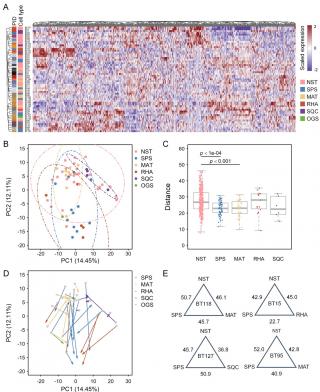Jan, 2023

Background: Metaplastic breast carcinoma (MpBC) typically consists of carcinoma of no special type (NST) with various metaplastic components. Although previous transcriptomic and proteomic studies have reported subtype-related heterogeneity, the intracase transcriptomic alterations between metaplastic components and paired NST components, which are critical for understanding the pathogenesis underlying the metaplastic processes, remain unclear.
Methods: Fifty-nine NST components and paired metaplastic components (spindle carcinomatous [SPS], matrix-producing, rhabdoid [RHA], and squamous carcinomatous [SQC] components) were microdissected from specimens obtained from 27 patients with MpBC for gene expression profiling using the NanoString Breast Cancer 360 Panel on a NanoString nCounter FLEX platform. BC360-defined signatures were scored using nSolver software.
Results: Hierarchical clustering and principal component analysis revealed a heterogeneous gene expression profile (GEP) corresponding to the NST components, but the GEP of metaplastic components exhibited subtype dependence. Compared with the paired NST components, the SPS components demonstrated the upregulation of genes related to stem cells and epithelial-mesenchymal transition and displayed enrichment in claudin-low and macrophage signatures. Despite certain overlaps in the enriched functions and signatures between the RHA and SPS components, the specific differentially expressed genes differed. We observed the RHA-specific upregulation of genes associated with vascular endothelial growth factor signaling. The chondroid matrix-producing components demonstrated the upregulation of hypoxia-related genes and the downregulation of the immune-related MHC2 signature and the TIGIT gene. In the SQC components, TGF-β and genes associated with cell adhesion were upregulated. The differentially expressed genes among metaplastic components in the 22 MpBC cases with one or predominantly one metaplastic component clustered paired NST samples into clusters with correlation with their associated metaplastic types. These genes could be used to separate the 31 metaplastic components according to respective metaplastic types with an accuracy of 74.2%, suggesting that intrinsic signatures of NST may determine paired metaplastic type. Finally, the EMT activity and stem cell traits in the NST components were correlated with specimens displaying lymph node metastasis.
Conclusions: We presented the distinct transcriptomic alterations underlying metaplasia into specific metaplastic components in MpBCs, which contributes to the understanding of the pathogenesis underlying morphologically distinct metaplasia in MpBCs.